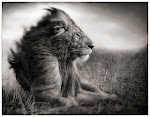
Much of this post is based off of or a response to the National Geographic article "Wolf Wars," should anybody be interested in reading it.
People feared wolves. Their fears were amplified by ancient superstitions and stories, and they reacted violently to these ancient predators. By the 1930s, wolves were exterminated from the lower 48 states. They were treated as vermin, as an infestation. The land lost a crucial element of the ecosystem.
Then, in 1995 and 1996, the U.S. Fish and Wildlife Service captured 68 wolves in Canada, and brought them to Yellowstone National Park in an effort to bring back the wolf population.
The wolves brought down were split into groups of alpha males and females, spreading out gene pools so as to cut down on inbreeding. Sometimes, the grouping worked, and sometimes it didn't. In all cases, the wolves began to flourish. By the end of 2008, there were more than 1,645 wolves recorded in the northern Rocky Mountain states, and not all of them were confined to the national park.
Hunters are one of the loudest voices in the opposition to the return of wolves. They view the new wolf population as four-legged killing machines, "land piranhas," ravaging the game population. States such as Idaho and Montana have set quotas for legal wolf hunting, and have allowed for the extension of the legal season several times. In Wyoming, wolves were declared as pests, and unlimited shooting of the wolves was allowed; a repeat of the attitude and regulation in the early 1900s. After several lawsuits, wolves were placed once again on the endangered species list in Wyoming, and they will remain there until Wyoming legislature agrees to change its regulations.
In the end, this tells me that hunters and supporters of sport hunting are complete hypocrites. The industry may bring in an estimated $11 million per year, but the competition will not only cut down the elk numbers--which have become a burden on the ecosystem--but will also bring better regulation of the shooting of big game in the US. It will make it so that the people who hunt for food or a living will be given the opportunity they deserve, while at the same time cutting down on the amount of game or sport hunting taking place. I'm not saying that hunting is bad, but the rules and regulations defy the laws of nature, and are unhealthy for animal populations.
Because of the 1970s regulation limiting the shooting of elk females, the elk population of Yellowstone and surrounding areas doubled. The numbers had grown to the point where the elk have become a burden on the ecosystem. Elk in Yellowstone over-browsed the stream-side willows, making it so the streams grew wider and shallower, cutting down on the populations of various fish species, as well as the beaver population. Aspen trees were becoming a dying breed, as elk ate the sprouts before they had a chance to grow. The area was overrun with elk, and with no reason to move on, they over-grazed fields and vegetation, leaving nothing to grow behind.
Now, with the introduction of wolves, the elk population has been cut in half. Now, elk don't linger long at stream sides and grazing areas, allowing a healthy cropping of vegetation without endangering the area. Beavers and trout are now flourishing, because it's dangerous for elk to stay too long along the streams. Aspen trees are now being given time to grow, as they should be.
A lot of the outcry against wolves is because of the marked decrease in elk numbers. This is because elk are not used to being hunted at any time of the year. They had no way to counter the wolves. We had removed a natural predator the elk had survived against for ages, and they became lazy. After the initial decrease, the elk are becoming less vulnerable prey. They are now more vigilant than ever, and stay on the move. Before the introduction of wolves, park officials were culling elk by the thousands. Now, they no longer need to. And not only that, but the wolves regulate their own population as well. "We have a declining wolf population," said Doug Smith, leader of the Yellowstone Wolf Project. "Numbers never got as high as we expected based on the availability of prey. This suggests that once the wolves reach a certain density, you start to get social regulation of their numbers." This to me, seems an improvement over the only other real hunters that elk knew. At least the wolves only take what they need, and they keep the hunters' number from rising too high. I'd love it if sport hunters started hunting each other to keep competition down and save the big game populations :P
Ranchers have a more reasonable objection, in my opinion. For them, the killing of their livestock is a direct attack on their livelihood, and it always hits some much harder than others. However, the reasons for the panic is much the same reason as for the hunters: we're not used to it. In Europe, there are many techniques that protect livestock. Bright flags attached to wire is a technique called fladry, and it has been successful in the areas applied. In addition, electric fencing protects calving pastures, which prevents many wolf attacks. And by removing the carcasses of cattle brought down by disease or accidents, ranchers can avoid attracting the attention of wolves in the first place. They also use the rancher rider program, in which a rancher monitors the whereabouts of wolf packs in relation to the cattle and reports to other ranchers so they can move their herds if need be.
And ultimately, the greatest defense against wolf attacks to evolve is the change in cattle behavior. Since they've been domesticated, and since the extermination of wolves in the lower 48, we've removed a large reason for cattle to retain any instinctual defense. Once again, they're just not used to it, and wolves have taken advantage of this. However, as time passes, the cattle are growing into less domestic animals, capable of defending themselves and their young. And this might even be a good thing for ranchers and livestock owners, preventing us from taking too many of the animals we've come to rely on.
But before you go and think that wolves have been ravaging the herds of livestock, be aware that in Idaho, Wyoming, and Montana, where wolf population has flourished, wolf kills account for about 1 percent of livestock loss. In sheep flocks, for examples, wolves are behind coyotes, cougars, weather, disease, old age, and lambing complications in amount of sheep killed, each of the listed accounting for 25, 1.4, 22.6, 11, and 9 percent, respectively.
Wolves are an integral component of our ecosystem, and by removing them we left a gaping hole in the balance of nature. Wolves are meant to be here. And all the other large mammals are changing their behavior to deal with the wolves: elk, bison, deer, and even cattle, whom we have domesticated. Instead of griping about a force of nature that we've tried once again to control, maybe we need to start living with the forces of nature.








No comments:
Post a Comment